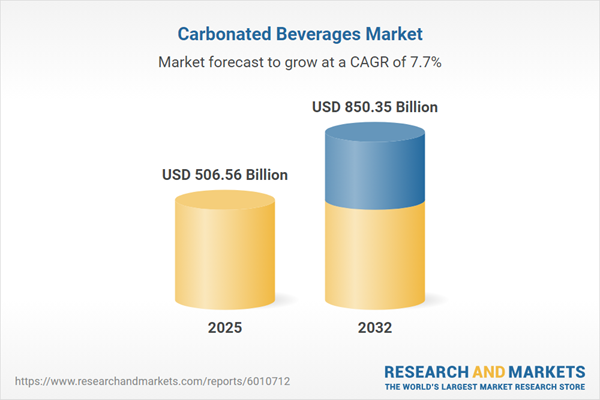Speak directly to the analyst to clarify any post sales queries you may have.
The carbonated beverages market is evolving rapidly, shaped by shifting consumer expectations, advances in technology, and new industry regulations. As demand grows for healthier options and sustainable business practices, industry leaders must realign strategies to remain competitive in this complex landscape.
Market Snapshot: Carbonated Beverages Market Size and Growth
The carbonated beverages market expanded from USD 471.08 billion in 2024 to USD 506.56 billion in 2025, with growth on track to reach USD 850.35 billion by 2032. This trajectory represents a compound annual growth rate (CAGR) of 7.66%, confirming robust global demand and rising sectoral importance. These figures highlight the significance of the carbonated beverages industry for companies intent on capturing value within food and beverage portfolios.
Scope & Segmentation
This report provides a comprehensive view of the carbonated beverages sector, covering:
- Product Types: Cola (including Diet, Regular, Zero Sugar), Lemon-Lime (Diet, Regular, Zero Sugar), Orange (Diet, Regular, Zero Sugar), Root Beer (Diet, Regular, Zero Sugar)
- Packaging Types: Can (Multi Serve, Single Serve), Fountain Dispensed (Multi Serve, Single Serve), Glass Bottle (Multi Serve, Single Serve), PET Bottle (Multi Serve, Single Serve)
- Ingredient Categories: Caffeinated (Added Caffeine, Natural Caffeine), Non Caffeinated
- Geographic Regions: Americas (including North America and Latin America), Europe, Middle East & Africa, and Asia-Pacific; with country-level insights across United States, Canada, Mexico, Brazil, Argentina, China, India, Japan, among others
- Key Players Analyzed: The Coca-Cola Company, PepsiCo, Inc., Keurig Dr Pepper Inc., Red Bull GmbH, National Beverage Corp., Monster Beverage Corporation, Nestlé S.A., Refresco Group NV, AG Barr plc, Suntory Holdings Limited
Key Takeaways for Senior Decision-Makers
- Consumer demand is diversifying, with brands expanding flavor portfolios and emphasizing product innovation to meet health and wellness priorities.
- Advanced packaging solutions—including lightweight materials and refill systems—are gaining traction, reshaping both sustainability initiatives and cost strategies.
- Digital engagement and direct-to-consumer models, such as subscription services and interactive campaigns, are transforming brand-consumer relationships and offering new channels for market entry.
- Regional differences require tailored approaches, as regulatory, supply chain, and consumer preferences vary widely between markets such as North America, Europe, Asia-Pacific, and emerging regions.
- Premiumization, driven by craft-inspired flavors and limited-edition collaborations, is redefining growth opportunities while reinforcing the importance of data analytics in audience segmentation.
- Status quo disruption is evident in both mainstream and niche players, with companies investing in flexible manufacturing and new ingredient sourcing strategies to enhance resilience.
Tariff Impact: Addressing New U.S. Trade Measures
Recent United States tariff measures have led to significant supply chain recalibrations, compelling manufacturers to renegotiate sourcing contracts and bolster domestic supplier relationships. Industry leaders are turning to vertical integration and scenario-based financial modeling to address evolving cost structures, while smaller players often collaborate with co-manufacturers to navigate tariff exemptions and maintain competitiveness. Ongoing stakeholder engagement remains essential as regulatory discussions progress.
Primary Keyword Insights: Carbonated Beverages Market Trends
Health-driven formulations, premium packaging, and increased focus on sustainability are setting the pace for the carbonated beverages market. Companies continue to innovate through new flavor combinations and transparent ingredient sourcing, while leveraging technology for real-time consumer engagement. As the sector adapts, understanding market segmentation and regional nuances is critical for effective strategy deployment.
Methodology & Data Sources
Research draws on structured interviews with industry stakeholders, a global survey of beverage professionals, and in-depth secondary sources. Analytical rigor includes advanced statistical modeling and multi-layered peer review, ensuring precise, actionable findings throughout the report.
Why This Report Matters
- Delivers clarity on emerging growth drivers and regulatory changes impacting the carbonated beverages landscape.
- Enables actionable decision-making with segmented insights on product types, packaging innovations, and key regional opportunities.
- Guides senior executives in developing resilient supply chains, tariff risk management, and data-driven brand positioning.
Conclusion
This report empowers industry leaders to make informed decisions in a rapidly shifting environment, highlighting critical trends, market challenges, and innovation strategies for sustainable growth in carbonated beverages.
Additional Product Information:
- Purchase of this report includes 1 year online access with quarterly updates.
- This report can be updated on request. Please contact our Customer Experience team using the Ask a Question widget on our website.
Table of Contents
3. Executive Summary
4. Market Overview
7. Cumulative Impact of Artificial Intelligence 2025
Companies Mentioned
The companies profiled in this Carbonated Beverages market report include:- The Coca-Cola Company
- PepsiCo, Inc.
- Keurig Dr Pepper Inc.
- Red Bull GmbH
- National Beverage Corp.
- Monster Beverage Corporation
- Nestlé S.A.
- Refresco Group NV
- AG Barr plc
- Suntory Holdings Limited
Table Information
| Report Attribute | Details |
|---|---|
| No. of Pages | 197 |
| Published | October 2025 |
| Forecast Period | 2025 - 2032 |
| Estimated Market Value ( USD | $ 506.56 Billion |
| Forecasted Market Value ( USD | $ 850.35 Billion |
| Compound Annual Growth Rate | 7.6% |
| Regions Covered | Global |
| No. of Companies Mentioned | 11 |









